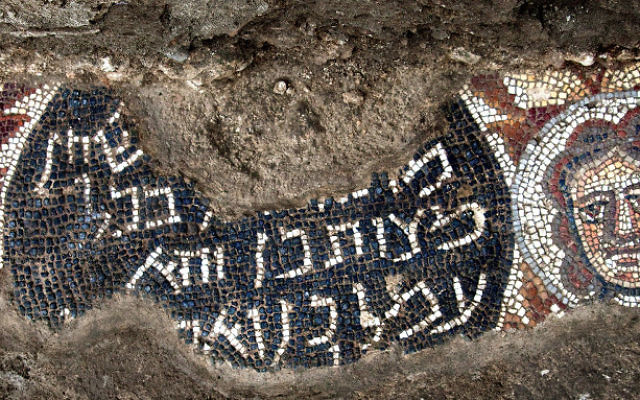Ancient Shul Reveals Its Secrets
By Rebecca McCarthy
Archaeologist Jodi Magness wanted to find an ancient synagogue in Israel, where she had worked for years. She began searching in the southeastern Galilee, three miles west of Capernaum and Migdal (Magdala), and zeroed in on Huqoq.
A small agricultural village, it had been abandoned in 1948 by 244 Arabs and bulldozed into rubble. But aerial photos showed a mounded area that Magness believed should be investigated. When she and her team started excavating years ago, they gradually found what she calls “the mother of all synagogues,” a large, elaborate structure that she thinks dates to the fifth century C.E.
Bit by bit, year by year, Magness is revealing the setting where Jews under Christianized Roman and Byzantine rule would have worshipped and celebrated festivals such as Passover.
Magness’ team includes students and experts from her own University of North Carolina at Chapel Hill as well as folks from Baylor, Brigham Young and the University of Toronto. Huqoq is both an excavation site and a field school for university students. With a wall more than 20 yards long, the Huqoq synagogue is larger than the better-known ancient synagogue in Capernaum. Unlike the many synagogues that have flagstone pavers in the floor, the Huqoq facility has mosaics filled with figured images. Unlike some ancient unearthed synagogues, the mosaics were intact.
Magness in March described her years of work and findings to a large crowd at Congregation Children of Israel in Athens. Those in attendance were synagogue members and people from the University of Georgia and Athens at large. The event was sponsored by the Sanford and Florence Schwartz Symposium Fund.
The team works only one month each year. By then, Magness said, the close contact among team members and the detailed, round-the-clock labor have taken their toil.
So one year they may find a section of a mosaic that gives a fuller story about the village and the artist when seen with its neighbor — and an even better sense when it’s part of a much larger whole. They dig up, see what’s there, photograph and describe it in great detail in notebooks, and then cover it up to protect it from any disturbance.
When the archaeology team members found the southwest corner of the synagogue, they saw a scene depicting what Magness believes to be Samson and several pairs of foxes — although Samson isn’t presented warmly in rabbinic literature.
She said the scene comes from the Book of Judges, Chapter 15. Samson is said to have caught 300 foxes, tied their tails in pairs with a firebrand between them, then released them in the Philistines’ fields to burn their crops and olive groves. There’s also an image of Samson carrying the gate of Gaza on his back.
In 2013, the team found a mosaic that shows an elephant with battle armor, though Magness remains convinced the artist never saw an elephant. The story the artist conveys doesn’t occur in the Hebrew Bible, which never mentions an elephant, so the mosaic is the earliest example of a nonbiblical story depicted in an ancient synagogue, Magness has said.
Also found were images of a bearded elderly man and several younger men in ceremonial robes with daggers.
The next year, Magness and her team uncovered a figure she believes to be a Greek king with a phalanx of soldiers. The battle elephants belong with him, she said, and that king could be Alexander the Great, conqueror of the world. Legends have come down about Alexander meeting with the Jewish high priest Jaddus of Jerusalem.
Last summer the team unearthed theater masks, held aloft by plump cupids, possibly satyrs, who were Dionysian figures. There are also scenes of dates being harvested and processed.






comments